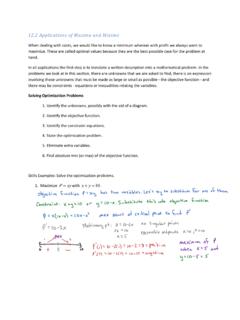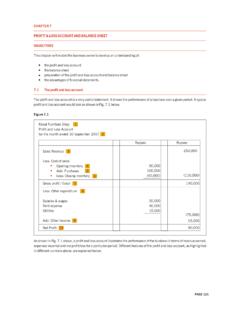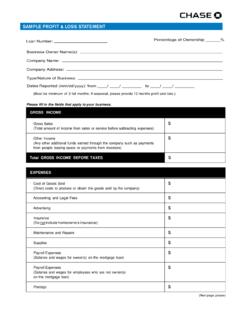Transcription of Cost, Revenue & Profit Examples - UTEP
1 Cost, Revenue & Profit Examples 1) A soft-drink manufacturer can produce 1000 cases of soda in a week at a total cost of $6000, and 1500 cases of soda at a total cost of $8500. Find the manufacturer's weekly fixed costs and marginal cost per case of soda. Solution: We would like to find a function that describes this situation. Recall that the marginal cost is , and in this case it represents the cost to produce one case of soda. The fixed costs are represented by . To answer the questions, we must find both and . Since this is a linear function, we can find using the formula for finding the slope of a line between two points, where the points here are and . The slope formula is So the marginal cost is.
2 This means it costs per case to manufacture the soft-drinks. Now that we have , we can find . We know that , so we can use what we were given to find . You can choose either ordered pair to do this, either or . We plug in the and values we know into our equation, and solve for : So . Thus the fixed costs are . This would represent things like rent, electricity and other bills, etc. 2) Your college newspaper, The Collegiate Investigator, has fixed production costs of $70 per edition, and marginal printing and distribution costs of 40 /copy. The Collegiate Investigator sells for 50 /copy. a) Write down the associated cost, Revenue , and Profit functions. b) What Profit (or loss ) results from the sale of 500 copies of The Collegiate Investigator?
3 C) How many copies should be sold in order to break even? Solutions: a) We are told that the marginal cost is per copy, and that the fixed costs are . This means that our cost function is Since they are selling the newspaper for per copy, the Revenue function is Since Profit is defined to be Revenue minus cost, the Profit function is b) We can find the Profit that results from selling 500 copies by finding , that is, plugging 500 into the Profit function. We get This means that if they sell 500 newspapers, it will result in a loss of . c) To find the break even quantity, we can either set Revenue equal to cost and solve for , or we can set Profit equal to zero and solve for.
4 If we set Profit equal to zero, we get Solving this for gives , so they must sell 700 newspapers in order to break even. 3) The cost of renting tuxes for the Choral Society's formal is $20 down, plus $86 per tux. Express the cost C as a function of x, the number of tuxedos rented. Solution: Since it costs $20 regardless of how many tuxes you rent, this is the fixed cost. Since it's $86 per tux, this is the marginal cost. The cost function is thus . Use your function to answer the following questions. a) What is the cost of renting 5 tuxes? Solution: Plug 5 into the cost function to find the cost to rent 5 tuxes: So it costs $450 to rent 5 tuxes. b) What is the cost of the 5th tux?
5 Solution: The cost of just the 5th tux (not the cost to rent 5 tuxes!) is $86 (which is the marginal cost, the cost per tux). c) What is the cost of the 3098th tux? Solution: The cost of the 3098th tux is $86. (Note that every tux, individually, costs $86 to rent). d) What is the variable cost? Solution: The variable cost is . e) What is the marginal cost? Solution: The marginal cost is . f) Graph the cost as a function of . Solution: The graph looks like this: Note that the -intercept is at 20. 4) Gymnast Clothing manufactures expensive hockey jerseys for sale to college bookstores in runs of up to 150. Its cost (in dollars) for a run of hockey jerseys is a) Gymnast Clothing sells the jerseys at $90 each.
6 Find the Revenue function. Solution: Since the manufacturer sells the jerseys for $90 each, the Revenue function is b) Find the Profit function. Solution: Profit is defined to be Revenue minus cost, so the Profit function is c) How many should Gymnast Clothing manufacture to make a Profit ? (Round your answer up to the nearest whole number.). Solution: In order to make a Profit , must be greater than zero. So, to find how many jerseys we need to make in order to make a Profit , we should find the break-even point. We can do this by setting Profit equal to zero and solving for . This will require the quadratic formula: This simplifies to or , but since the problem specifies that the domain is between and , we can reject the larger answer.
7 Rounding the other answer up, we get . So, if we make 20 jerseys, we will make a Profit .













